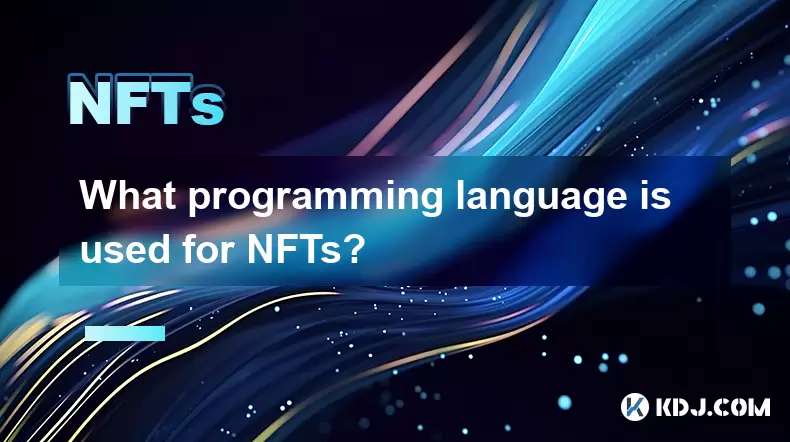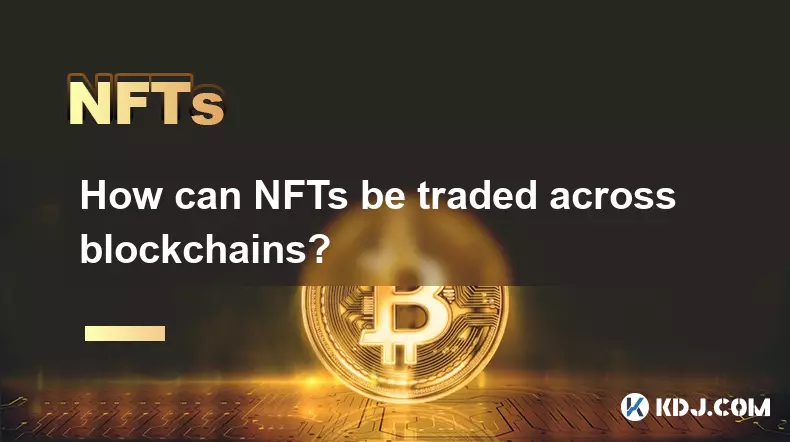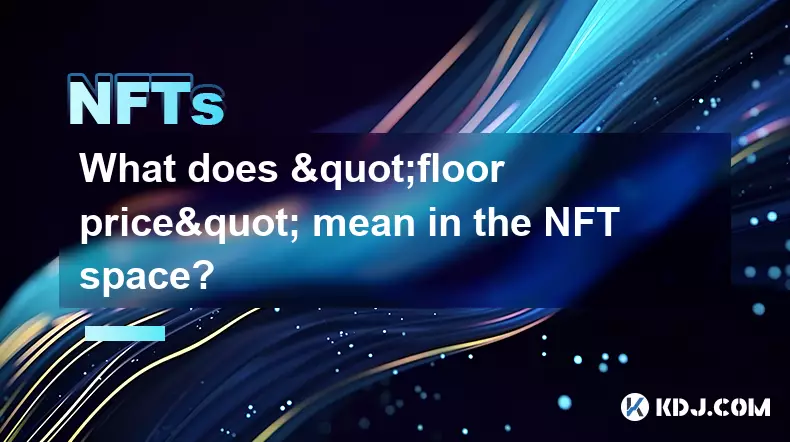-
 bitcoin
bitcoin $109523.663807 USD
-0.13% -
 ethereum
ethereum $4019.526508 USD
2.06% -
 tether
tether $1.000482 USD
0.00% -
 xrp
xrp $2.776815 USD
0.18% -
 bnb
bnb $958.942396 USD
0.12% -
 solana
solana $204.294698 USD
3.84% -
 usd-coin
usd-coin $0.999693 USD
0.00% -
 dogecoin
dogecoin $0.232115 USD
2.09% -
 tron
tron $0.338028 USD
0.84% -
 cardano
cardano $0.790920 USD
1.50% -
 hyperliquid
hyperliquid $44.871443 USD
5.60% -
 ethena-usde
ethena-usde $1.000322 USD
0.04% -
 chainlink
chainlink $21.034165 USD
2.60% -
 avalanche
avalanche $28.794831 USD
-0.54% -
 stellar
stellar $0.360466 USD
1.24%
What programming language is used for NFTs?
NFT development relies on languages like Solidity for Ethereum smart contracts, with options like Rust, Python, and JavaScript supporting diverse blockchain platforms and full-stack integration.
Jul 20, 2025 at 11:28 pm

Understanding the Role of Programming Languages in NFT Development
Non-Fungible Tokens (NFTs) are digital assets that represent ownership or proof of authenticity of a unique item or piece of content, often stored on a blockchain. The creation and management of NFTs involve various programming languages that serve different functions within the development lifecycle. While no single language is exclusively used for NFTs, several are commonly employed depending on the platform, functionality, and complexity required.
Smart contracts form the backbone of most NFTs, especially those built on blockchains like Ethereum. These self-executing contracts define the rules and behaviors of an NFT, such as transferability, metadata storage, and royalty mechanisms.
Ethereum and Solidity: The Dominant Ecosystem
The majority of NFTs today are created on the Ethereum blockchain, which supports smart contracts through its native programming language called Solidity. Solidity is specifically designed for writing smart contracts on Ethereum-based platforms. It resembles JavaScript in syntax but includes features tailored to blockchain environments.
Developers use Solidity to implement standards such as ERC-721 and ERC-1155, which are widely adopted protocols for creating NFTs. These standards ensure compatibility across marketplaces and wallets by defining how NFTs should behave when transferred, queried, or interacted with.
Other Blockchain Platforms and Their Languages
While Ethereum remains the most popular choice for NFT development, other blockchains also support NFT creation using different programming languages:
- Binance Smart Chain uses Solidity as well, making it relatively easy for developers familiar with Ethereum to transition between these ecosystems.
- Tezos utilizes Liquidity and SmartPy, where SmartPy is a Python-based framework that allows developers to write and test smart contracts visually before deployment.
- Flow blockchain employs Cadence, a resource-oriented language developed by Dapper Labs specifically for building secure and scalable decentralized applications, including NFTs.
- Polkadot and Substrate-based chains can leverage Rust, a systems programming language known for performance and safety, particularly useful for high-throughput NFT applications.
Each of these languages offers unique advantages depending on the project's goals, scalability requirements, and developer expertise.
Frontend and Backend Integration
Beyond smart contract development, NFT projects often require robust frontend and backend components. These aspects typically involve more traditional web development languages and frameworks:
- JavaScript and TypeScript are widely used for both frontend (React, Vue.js) and backend (Node.js) development, enabling seamless integration with blockchain tools via libraries like Web3.js or Ethers.js.
- Python is frequently used for backend logic, scripting, and data analysis related to NFT analytics or minting automation.
- Go (Golang) may be used for high-performance backend services, especially when interacting with blockchain nodes or handling large volumes of transactions.
These languages work alongside blockchain-specific ones to provide a full-stack experience, from user interfaces to on-chain interactions.
Tools and Libraries That Enhance NFT Development
Several development tools and libraries simplify the process of building NFTs, regardless of the underlying programming language:
- Truffle Suite provides a development environment, testing framework, and asset pipeline for Ethereum-based smart contracts written in Solidity.
- Hardhat is another popular tool for Solidity development, offering advanced debugging and task automation features.
- IPFS (InterPlanetary File System) is not a programming language but a critical infrastructure for storing NFT metadata off-chain while maintaining decentralization.
- OpenZeppelin offers reusable, secure smart contract templates, including implementations of ERC-721 and ERC-1155 standards.
These tools help streamline workflows and enhance security, making them essential for efficient NFT development.
Frequently Asked Questions (FAQ)
Q: Can I create NFTs without knowing any programming language?Yes, platforms like OpenSea, Mintable, and Rarible allow users to mint NFTs without coding knowledge by providing pre-built smart contracts and intuitive interfaces.
Q: Is it necessary to learn Solidity if I want to develop NFTs on Ethereum?While some platforms abstract away the need for direct Solidity coding, understanding it gives you greater control over customization, security, and optimization of your NFTs.
Q: Are there any visual tools for developing NFT smart contracts?Yes, tools like Remix IDE offer browser-based environments for writing and deploying Solidity contracts, and SmartPy provides a visual interface for Tezos-based smart contracts.
Q: How do I choose the right programming language for my NFT project?Consider factors such as the target blockchain, team expertise, scalability needs, and ecosystem support. Researching existing projects and community resources can guide your decision.
Disclaimer:info@kdj.com
The information provided is not trading advice. kdj.com does not assume any responsibility for any investments made based on the information provided in this article. Cryptocurrencies are highly volatile and it is highly recommended that you invest with caution after thorough research!
If you believe that the content used on this website infringes your copyright, please contact us immediately (info@kdj.com) and we will delete it promptly.
- BTC, Hard Fork, and Disputed Futures: A Bitcoin Knots Controversy
- 2025-09-28 01:05:16
- Litecoin, Remittix, and Crypto Payments: A New Era?
- 2025-09-28 01:05:16
- Crypto Presales: Is $BFX the Next Big Thing?
- 2025-09-28 00:25:12
- Kraken's IPO Ambitions: Navigating Valuation in a Recovering Crypto Market
- 2025-09-28 00:25:12
- World Liberty Financial (WLFI): Buyback & Burn Bonanza - Will the Price Ignite?
- 2025-09-28 00:45:12
- Bitcoin's Bumpy Ride: Navigating Risks and Potential Downturns
- 2025-09-28 00:30:01
Related knowledge

How can I determine the authenticity of an NFT project?
Sep 23,2025 at 05:18pm
Understanding the Project Team and Their Background1. Research the identities of the team members behind the NFT project. Verified social media profil...

What's the difference between NFTs and traditional collectibles?
Sep 19,2025 at 12:55pm
Digital Ownership and Provenance1. NFTs are built on blockchain technology, which ensures transparent and immutable records of ownership. Every transa...

How can NFTs be traded across blockchains?
Sep 19,2025 at 12:00pm
Understanding Cross-Chain NFT Trading1. Non-fungible tokens (NFTs) are digital assets that represent ownership of unique items on a blockchain. Origin...

How is NFT rarity calculated?
Sep 18,2025 at 07:54pm
Understanding NFT Rarity Metrics1. NFT rarity is determined by analyzing the uniqueness of individual traits within a collection. Each NFT typically c...

What does "floor price" mean in the NFT space?
Sep 22,2025 at 06:36am
Floor Price: A Core Metric in the NFT Marketplace1. The term floor price refers to the lowest current asking price for any item within a specific NFT ...

How do NFTs help content creators?
Sep 18,2025 at 08:00am
NFTs Empower Creators with Ownership and Monetization1. NFTs provide content creators with verifiable ownership of their digital works, ensuring authe...

How can I determine the authenticity of an NFT project?
Sep 23,2025 at 05:18pm
Understanding the Project Team and Their Background1. Research the identities of the team members behind the NFT project. Verified social media profil...

What's the difference between NFTs and traditional collectibles?
Sep 19,2025 at 12:55pm
Digital Ownership and Provenance1. NFTs are built on blockchain technology, which ensures transparent and immutable records of ownership. Every transa...

How can NFTs be traded across blockchains?
Sep 19,2025 at 12:00pm
Understanding Cross-Chain NFT Trading1. Non-fungible tokens (NFTs) are digital assets that represent ownership of unique items on a blockchain. Origin...

How is NFT rarity calculated?
Sep 18,2025 at 07:54pm
Understanding NFT Rarity Metrics1. NFT rarity is determined by analyzing the uniqueness of individual traits within a collection. Each NFT typically c...

What does "floor price" mean in the NFT space?
Sep 22,2025 at 06:36am
Floor Price: A Core Metric in the NFT Marketplace1. The term floor price refers to the lowest current asking price for any item within a specific NFT ...

How do NFTs help content creators?
Sep 18,2025 at 08:00am
NFTs Empower Creators with Ownership and Monetization1. NFTs provide content creators with verifiable ownership of their digital works, ensuring authe...
See all articles









































































